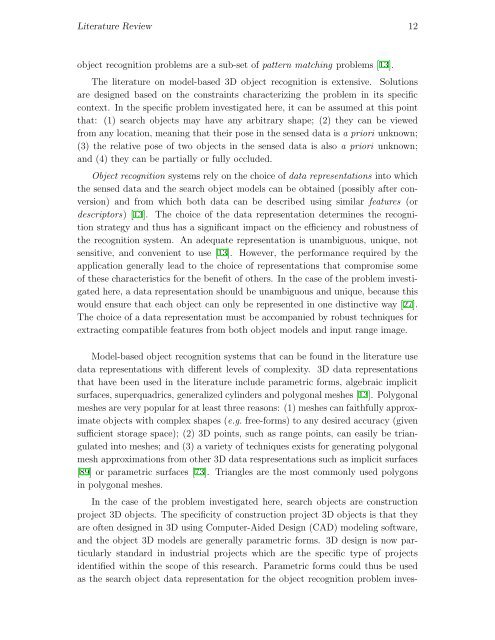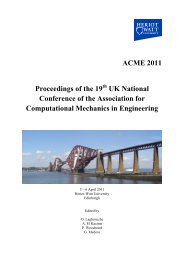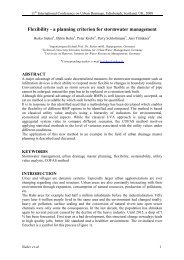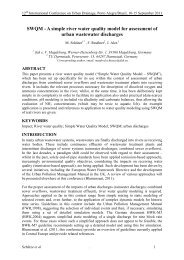PhD Thesis - Automated Recognition of 3D CAD Model Objects in ...
PhD Thesis - Automated Recognition of 3D CAD Model Objects in ...
PhD Thesis - Automated Recognition of 3D CAD Model Objects in ...
Create successful ePaper yourself
Turn your PDF publications into a flip-book with our unique Google optimized e-Paper software.
Literature Review 12<br />
object recognition problems are a sub-set <strong>of</strong> pattern match<strong>in</strong>g problems [13].<br />
The literature on model-based <strong>3D</strong> object recognition is extensive. Solutions<br />
are designed based on the constra<strong>in</strong>ts characteriz<strong>in</strong>g the problem <strong>in</strong> its specific<br />
context. In the specific problem <strong>in</strong>vestigated here, it can be assumed at this po<strong>in</strong>t<br />
that: (1) search objects may have any arbitrary shape; (2) they can be viewed<br />
from any location, mean<strong>in</strong>g that their pose <strong>in</strong> the sensed data is aprioriunknown;<br />
(3) the relative pose <strong>of</strong> two objects <strong>in</strong> the sensed data is also aprioriunknown;<br />
and (4) they can be partially or fully occluded.<br />
Object recognition systems rely on the choice <strong>of</strong> data representations <strong>in</strong>to which<br />
the sensed data and the search object models can be obta<strong>in</strong>ed (possibly after conversion)<br />
and from which both data can be described us<strong>in</strong>g similar features (or<br />
descriptors) [13]. The choice <strong>of</strong> the data representation determ<strong>in</strong>es the recognition<br />
strategy and thus has a significant impact on the efficiency and robustness <strong>of</strong><br />
the recognition system. An adequate representation is unambiguous, unique, not<br />
sensitive, and convenient to use [13]. However, the performance required by the<br />
application generally lead to the choice <strong>of</strong> representations that compromise some<br />
<strong>of</strong> these characteristics for the benefit <strong>of</strong> others. In the case <strong>of</strong> the problem <strong>in</strong>vestigated<br />
here, a data representation should be unambiguous and unique, because this<br />
would ensure that each object can only be represented <strong>in</strong> one dist<strong>in</strong>ctive way [27].<br />
The choice <strong>of</strong> a data representation must be accompanied by robust techniques for<br />
extract<strong>in</strong>g compatible features from both object models and <strong>in</strong>put range image.<br />
<strong>Model</strong>-based object recognition systems that can be found <strong>in</strong> the literature use<br />
data representations with different levels <strong>of</strong> complexity. <strong>3D</strong> data representations<br />
that have been used <strong>in</strong> the literature <strong>in</strong>clude parametric forms, algebraic implicit<br />
surfaces, superquadrics, generalized cyl<strong>in</strong>ders and polygonal meshes [13]. Polygonal<br />
meshes are very popular for at least three reasons: (1) meshes can faithfully approximate<br />
objects with complex shapes (e.g. free-forms) to any desired accuracy (given<br />
sufficient storage space); (2) <strong>3D</strong> po<strong>in</strong>ts, such as range po<strong>in</strong>ts, can easily be triangulated<br />
<strong>in</strong>to meshes; and (3) a variety <strong>of</strong> techniques exists for generat<strong>in</strong>g polygonal<br />
mesh approximations from other <strong>3D</strong> data respresentations such as implicit surfaces<br />
[89] or parametric surfaces [73]. Triangles are the most commonly used polygons<br />
<strong>in</strong> polygonal meshes.<br />
In the case <strong>of</strong> the problem <strong>in</strong>vestigated here, search objects are construction<br />
project <strong>3D</strong> objects. The specificity <strong>of</strong> construction project <strong>3D</strong> objects is that they<br />
are <strong>of</strong>ten designed <strong>in</strong> <strong>3D</strong> us<strong>in</strong>g Computer-Aided Design (<strong>CAD</strong>) model<strong>in</strong>g s<strong>of</strong>tware,<br />
and the object <strong>3D</strong> models are generally parametric forms. <strong>3D</strong> design is now particularly<br />
standard <strong>in</strong> <strong>in</strong>dustrial projects which are the specific type <strong>of</strong> projects<br />
identified with<strong>in</strong> the scope <strong>of</strong> this research. Parametric forms could thus be used<br />
as the search object data representation for the object recognition problem <strong>in</strong>ves-













